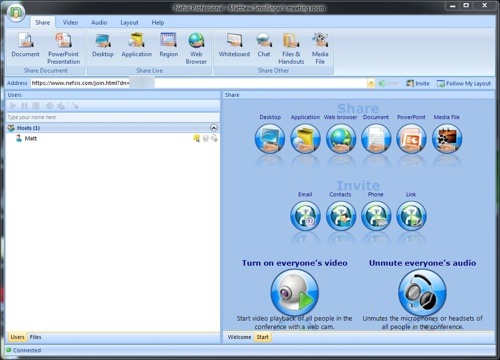
| At a glance | |
|---|---|
| Product | Nefsis Nefsis () [Website] |
| Summary | Cloud-based HD video conferencing service with a rich feature set. |
| Pros | • Easy Setup • HD Video looks good • Lots of features • Good support |
| Cons | • Expensive compared to competition • No cross-platform or mobile support • Some odd problems with video files • Pricing must be individually quoted by salesperson |
Typical Price: $350
|
||||||||||||||||||||||||||||
Nefsis’s cloud-based video solution aims to be the “end-all” to Internet video conferencing. It’s a lofty goal, to be sure. Entrenched competition from Cisco/Webex, Gotomeeting, and Skype is fierce, not to mention newcomers like LogMeIn’s Join.Me. Nefsis has its work cut out for it.
Nefsis has a few tricks up its sleeve though, like HD 720p video conferencing, complete layout control and the ability to share nearly any kind of document or media file. Some other neat features include granular host control over presenters, multiple conference “rooms” and collaboration features like a communal whiteboard.
Before we get into the service itself, let’s take a look at the different products they offer.
Products and Account Types
Nefsis offers basically two product tiers: a free and a Pro version. Free is limited to video conferencing between two people, and at a tiny video resolution of 352×288 at 15 FPS. Think of this as essentially the same thing you might get with the free version of Skype.
Pro is where all the good features are. This level unlocks all the advanced collaboration features, unlimited endpoint video chat, and all the rest of the major product features. Pro comes in both hosted and dedicated forms. Dedicated isn’t truly dedicated, but more like a hybrid cloud approach. You can, however, tweak the configuration so that the cloud is used only for authentication, which is fairly close to dedicated.
Pricing is all custom quoted. We tried to get Nefsis to give us some example scenarios and ballpark estimates. But they insisted that customers must contact them for the most accurate pricing. We did some snooping though and ran across an eWeek article from last year that quoted pricing at $350 per month for five concurrent users, with volume licensing and discounts available. Nefsis confirmed they were in that ballpark.
When I worked for a professional audio/visual dealership, we worked mostly off of a quoted base because nearly every project was custom. I’m not entirely sure why Nefsis feels the pro-line product needs to be quoted by a sales person everytime, since other solutions like Webex and Skype get along just fine without it. The dedicated solution I can kind of understand needing custom quoting, but not the cloud hosted version.
Using the only pricing information we could get, Nefsis is rather expensive compared to Webex, which charges per host, not per participant. Even with five hosts, Webex still comes in less than Nefsis at $245 a month. The products have different feature sets, with Webex recently making a heavy push into mobile, whereas Nefsis has focused on HD video, which Webex does not currently have. I would recommend comparing at least these two heavily before making a decision.
For the review, Nefsis provided us with the Pro service hosted in Nefsis’ cloud.
Installation and Setup
|
||||||||||||||||||
Nefsis is a “browser-based” product. I use quotes because it actually installs a.NET/Delphi application onto your machine. Mac OS users need not apply, for now. Nefsis says they are working on a native client for Mac OS but it isn’t ready yet.
The browser addon/extension for IE and Firefox that you are prompted to load during installation is merely a loader application. Chrome users have to download a “launcher.exe” every time they want to join a room, which can get annoying after a while. Thankfully the installation only occurs once, so on a relatively recent computer the client should load quickly.
Being Mr. Bleeding Edge, I’ve been running Firefox 4 Betas & Release Candidates (an excellent update, by the way). Subsequently, I had Firefox 4 when it released on day one, and tried out Nefsis’ extension. The extension does not load correctly in FF4 for now, but loads fine in Firefox 3.6.
The client itself is very peculiar in that even though it installs, it doesn’t actually “install” itself in the traditional Windows sense, when installed from the browser. Depending on your Windows version, you’ll find a WiredRed folder in Program Files and settings in one of your profile folders. (Nefsis the product was formerly known as E/POP and the company was named WiredRed.) But you’ll find no trace of it in the Windows Add/Remove Programs or Programs and Features Control Panels, nor will you find a shortcut in the Start Menu.
Nefsis said it can provide MSI or EXE based installers which will install normally (and allow uninstallation). But one of my pet peeves is software that just junks up my computer and isn’t easy to uninstall. At least with WebEx and Gotomeeting, I can easily uninstall their clients afterwards.
I ran a search through the registry looking for Nefsis, and other than things Windows added to handle document types, there wasn’t a trace of it. At least that was a good sign, because I really would’ve been annoyed had Nefsis also junked up my registry.
Once installed, the client will load the conference room you wanted to join. Joining a conference room is either via a direct web link, logging into your portal and going to your conference room or going to Nefsis.com and entering the conference ID and password (if any).
There are some modifications you can make yourself in the portal. You can change the default abilities that participants have, along with presenter abilities and you can add additional logins for your account, assuming you have the licensing needed. Groups can also be set up to determine access capabilties like setting up new conference rooms.
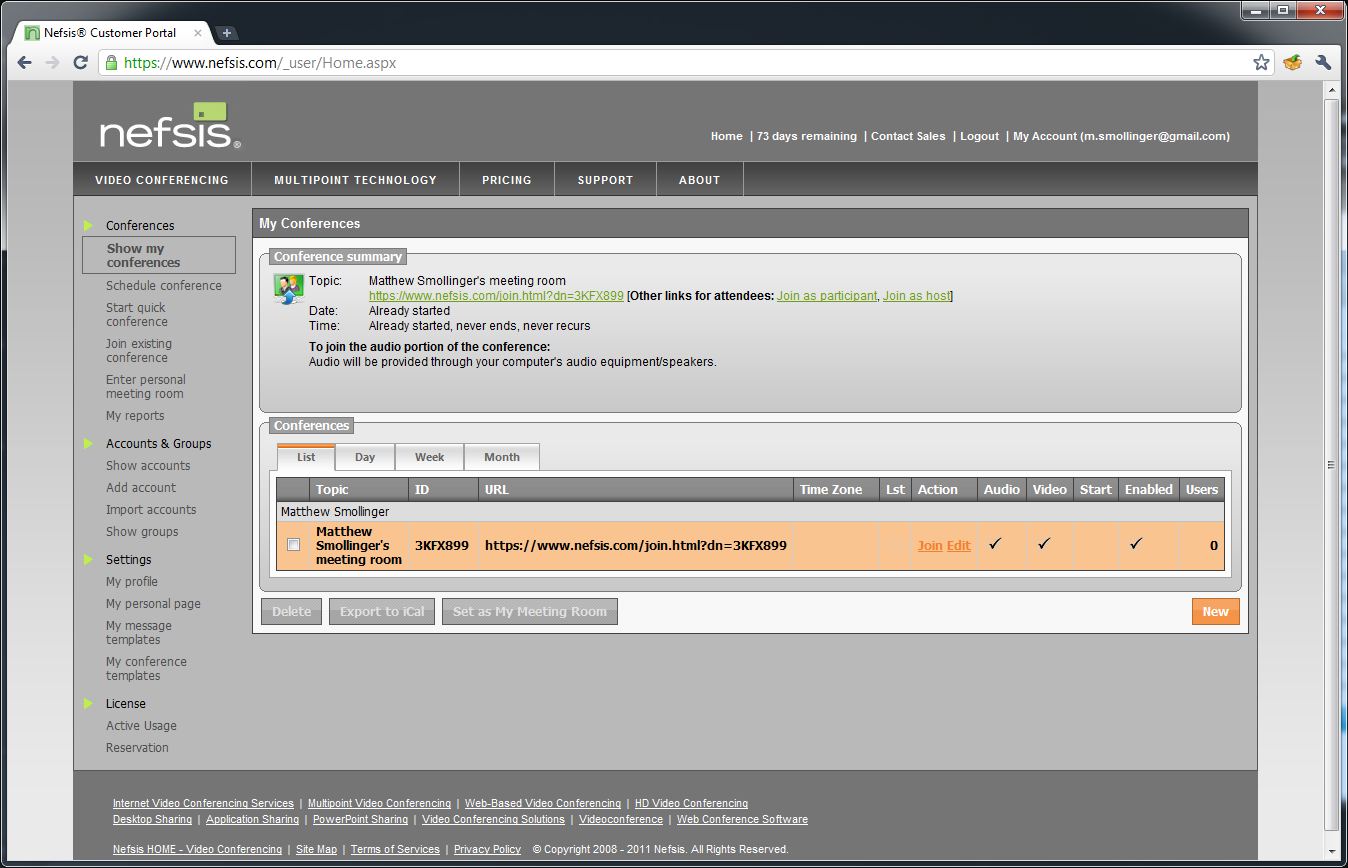
Initial room setup on the Nefsis website.

The Nefsis client, with a meeting started.
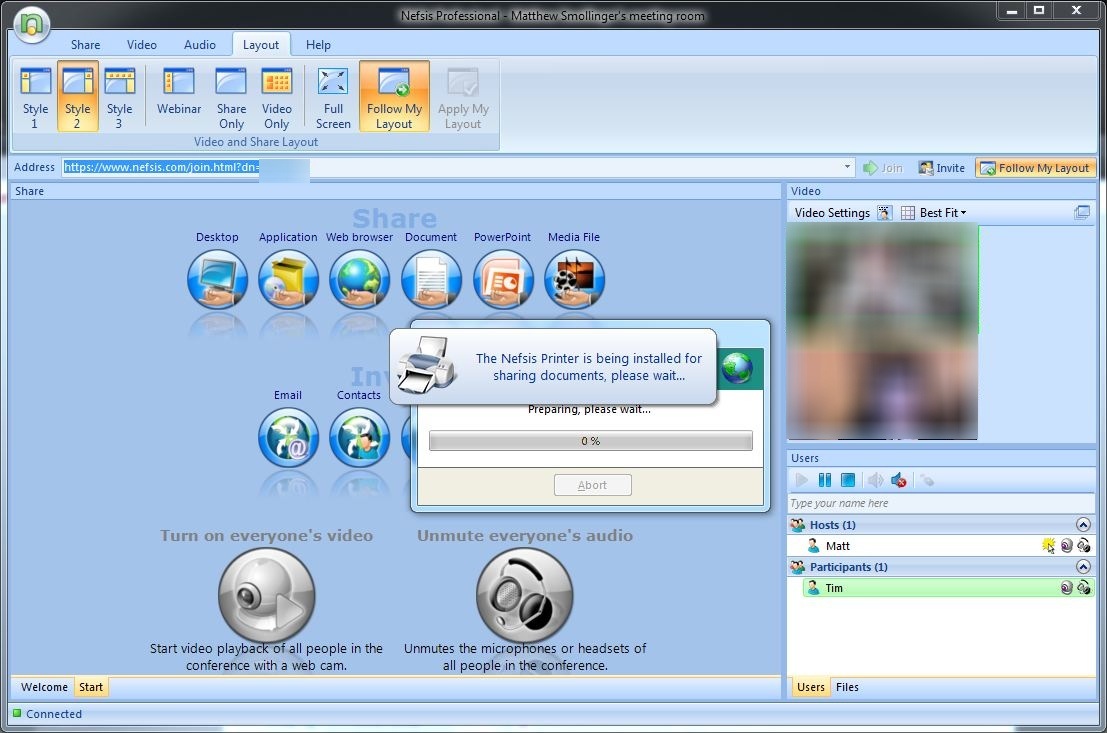
Nefsis installs a printer to upload documents for sharing.
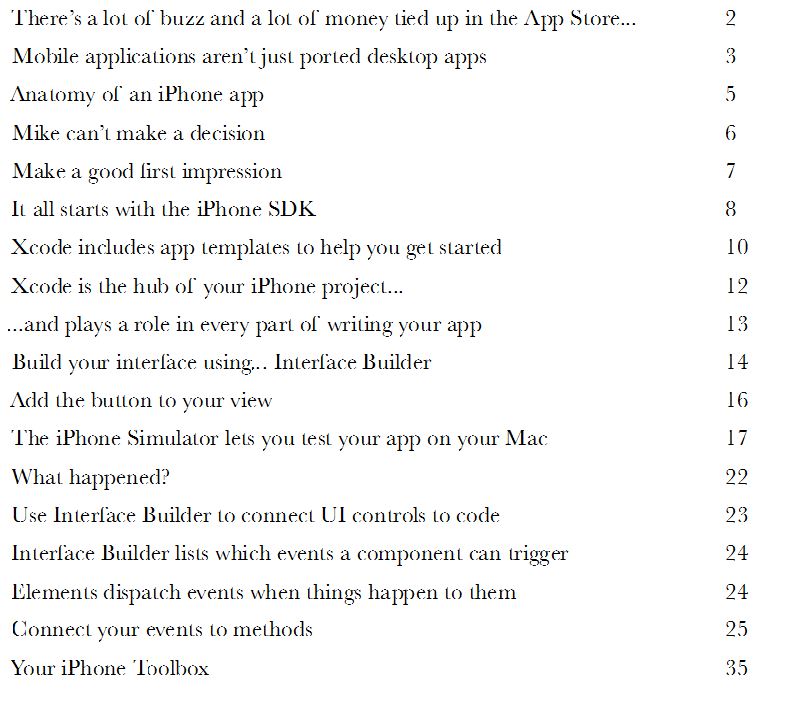
Here are some of the font issues mentioned.
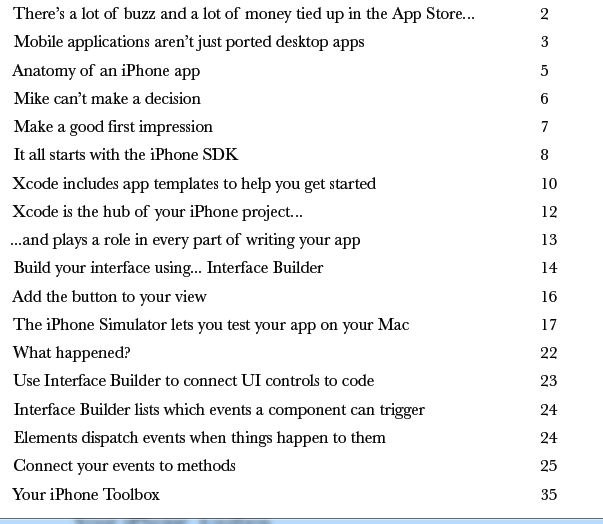
Here is the original PDF for comparison.
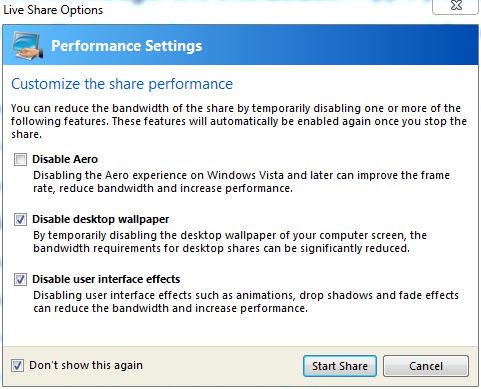
Nefsis asks what to disable to improve performance on your system when sharing desktops.

Sharing an individual application attaches the whiteboard bar to the application.

There are lots of granular options for setting different privilege levels.

The whiteboard works well enough.
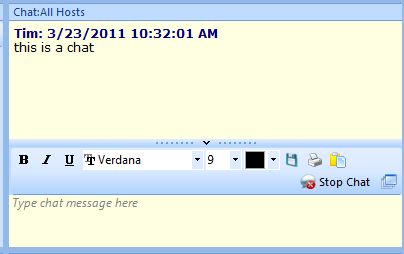
An included chat for when audio is disabled.
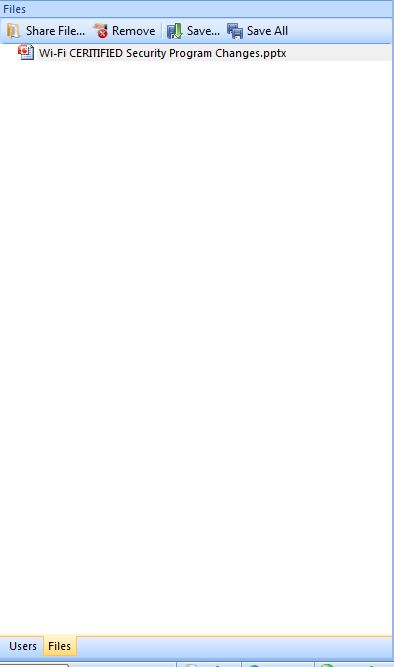
Access to shared files is placed in a tab that’s easily missed, but it works.
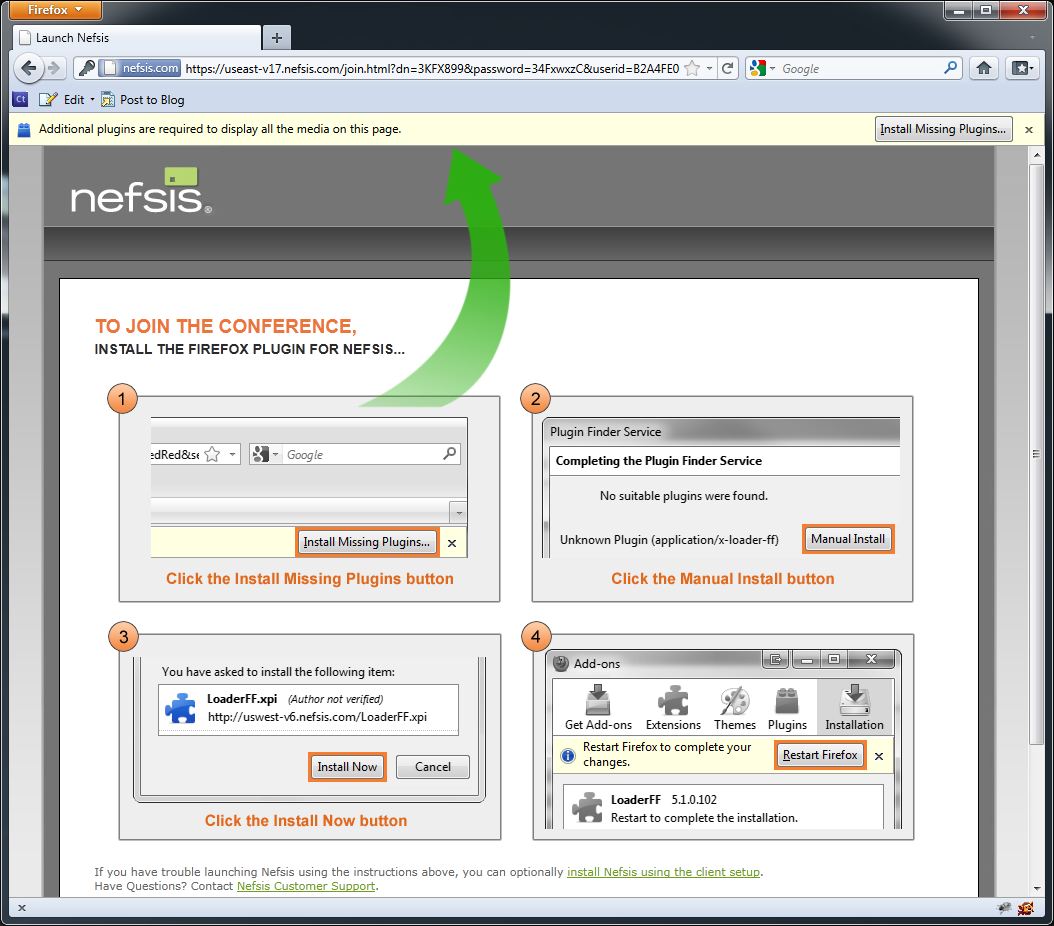
Installing the Firefox add-on was a pain, and it doesn’t work in Firefox 4.
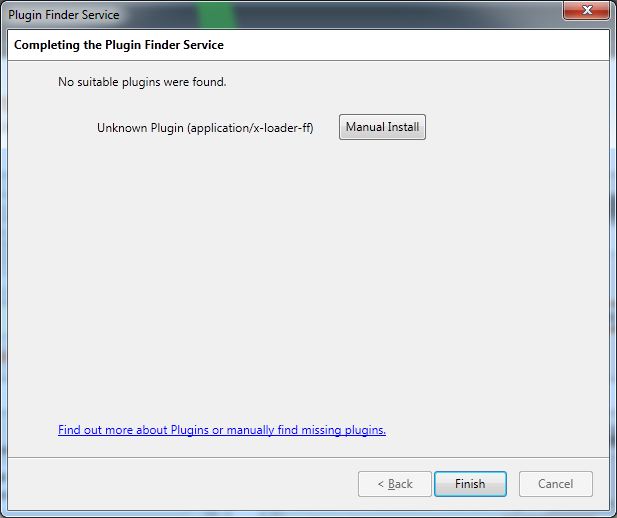
2nd step.
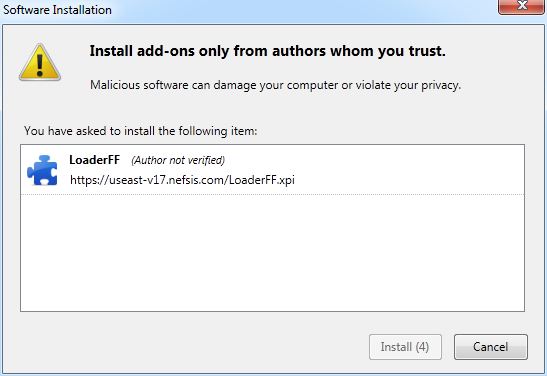
3rd step.
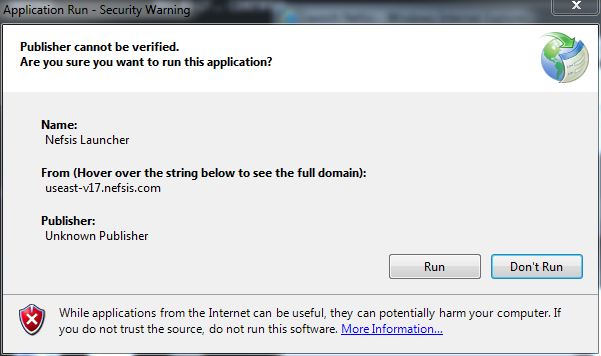
IE8 Nefsis installation is much simpler.
In-Use
Nefsis has a lot of bells and whistles. We’ll start off with the biggest one: HD Video. Nefsis has reviewed a number of HD webcams and higher-end room cameras for use with the system. I used a Logitech C910, as did Tim for this review, and it provided a very good image all around, which some HD webcams do not.
HD video requires a lot more of the client machine. Nefsis recommends a multi-core machine because their software is multi-threaded. Tim’s computer, a Core 2 Duo running Win XP SP3, showed an average of 30% CPU used, with the usage split between both cores.
On the other hand, my Core i7 quad core Win 7 system showed the four primary cores in use, with Core #3 taking a good bit of the load but the others were working as well. Overall, my system used about 6-8% of available processing power.
HD Video also requires fast Internet connections on both ends. I ran one Nefsis test session and had a fairly good experience with HD video running over my 25/25 Fios connection, using only about 2 Mbps upload speed.
When testing with Tim, the video was slightly choppier. This was due to Tim’s DSL connection which is only 800 Kbps up. So Nefsis will definitely take advantage of the higher speed connections, and saturate lower bandwidth links (and subsequently reduce video quality). The upside with the cloud is it won’t need more than 2 Mbps up, since no one is connecting directly to your feed.
Download speeds varied depending on number of people in conference and what we were sharing. Three people in a conference room sharing a movie file (more on that in a bit) required about 4.5 Mbps down while streaming the three video streams and the media file playing. Unlike in Skype, your video window in Nesfis is the video window your party also sees, so it’s a live preview.
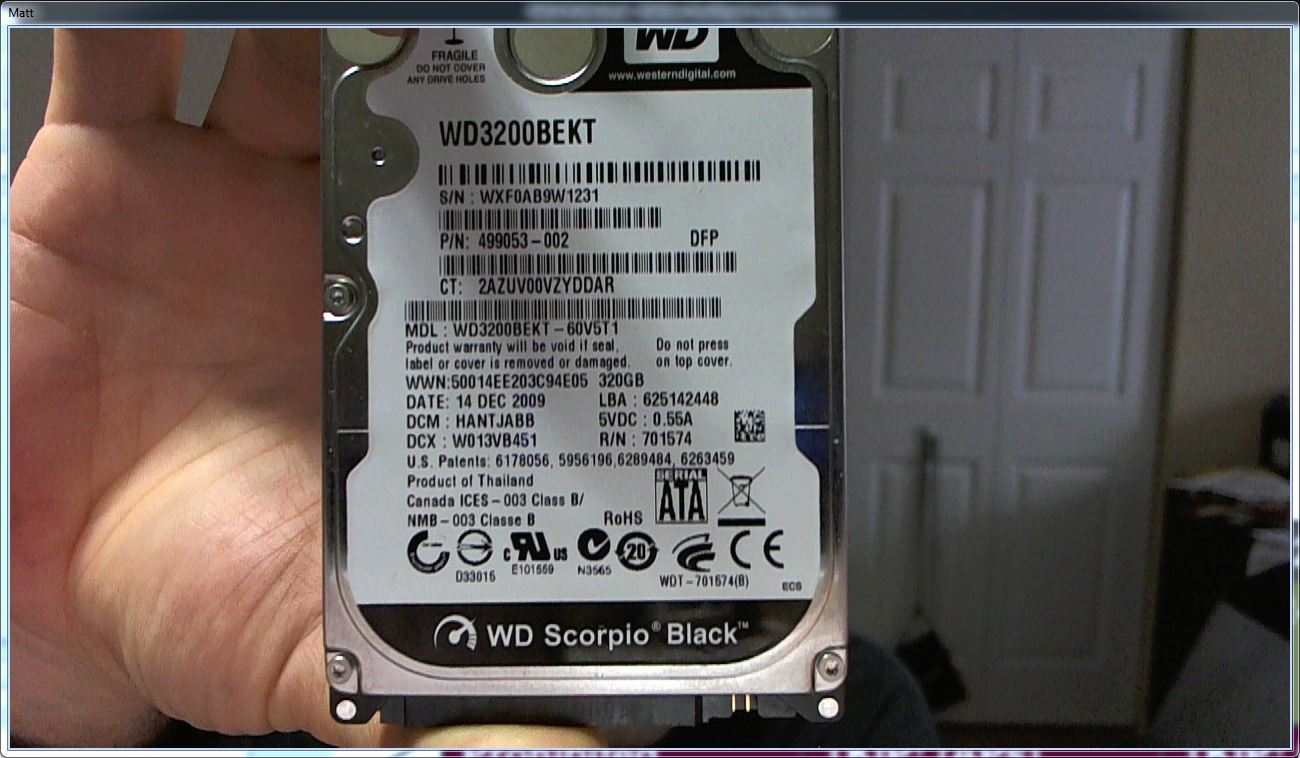
An example of the HD video off the Logitech C910 from Nefsis. You can see the creases in my hand, along with all the fingerprints on the shiny metal of the hard drive.
Hosts and Presenters have a ton of control available. You can force the screen full screen, change the layout from a webinar layout to a class roon layout, and float video windows out of the static preview boxes. All these changes can be forced down to the clients, so they see everything you do.
On of the more annoying things I found was how the audio is handled. When people join, it’s up to the host / presenter to unmute them. I understand why it’s like this, but there should be a preference where you can change so that people are unmuted when they join a conference. For impromptu meetings, its annoying to have to interrupt your process and find the unmute button.
I played around with recording the test conference, and came away somewhat underwhelmed. The audio and the primary sharing screen were recorded, but not the video. Compared to rich media solutions from, say, Sonic Foundry, it’s not going to impress. Granted, this isn’t the market Nefsis is aiming for. But I wouldn’t count conference recording as a key selling point of the system.
Sharing
One of the main features of web conferencing is collaboration. So what can you collaborate on with Nefsis? Just about anything, it turns out. To test things out, I uploaded a 500 page PDF of a technical manual. It took for….eve….er to upload, but it did eventually finish and got distributed to Tim. We both noticed that the text quality was noticeably degraded when opened in its default view. But enlarging the page cleared up the text somewhat. Take a look in the gallery at the screen shots for an example.
Video can also be shared. This is done by uploading a video in the Media section of the application. If the video is supported by Nefsis, it will upload and play to all viewers, and is fully controllable by the host. Nefsis utilizes Microsoft DirectShow filters to properly handle encoding, which means AVI, MPEG, MP4, and MOV are supported, but not all encoding types are available. Certain MP4s and MOVs I had would not upload correctly, while others would.
Everything (except video) can have a whiteboard layered over top of it and drawn on. It’s a great feature that works well, especially for people who are more visual with their explanations. Anyone can access it as long as they are given proper permissions, so you can quickly mark up a document. The changes, however, are not saved to the document itself, so you can’t send it to someone to view.
The obligatory Powerpoint sharing is there as well, but we ran into a problem during our test. Tim uses Office 2000 with the Office Compatibility Pack when he needs to open the newer Office "X" formatted files. When he tried to share a PPTX file with me, Nefsis threw an error.
Nefsis confirmed that if you are using an older version of Office that does not natively handle the newer formats, and you installed the “add-on” from Microsoft, you cannot present these files in Nefsis without having a newer version of Office that actually is designed for PPTX formats. This only affects hosts/presenters that are sharing a newer format file, participants don’t even have to have PowerPoint on their systems.
|
||||||||||||||
Access, Support, Security, Closing Thoughts
Access is accomplished starting on the web, but ends up being mostly through the Windows client. There is no mobile client support as of yet, although it might be on Nefsis’ roadmap, seeing as the iPad2 and the Xoom both have forward-facing cameras. The website provides some basic administrative control, like setting up groups.
Security is on par with other cloud-based video conferencing solutions. HTTPS is used for all connections, and all files get stored unencrypted on Nefsis’ servers. If you aren’t ok with the storage policy, Nefsis does offer their dedicated server environment that will allow you to store files on the dedicated server.
Support is very good, with lots of user guides, tutorial videos, FAQs and forums. Paying customers get access to telephone support, video conferencing with desktop sharing, and assistance with room-based peripherals (aka cameras). Dedicated server customers get additional engineering assistance to set up the system properly.
In closing, Nefsis is a well-rounded Internet video conferencing product with many features and premium pricing. If you need mobile access or cross-platform support, however, Nefsis isn’t there yet.
